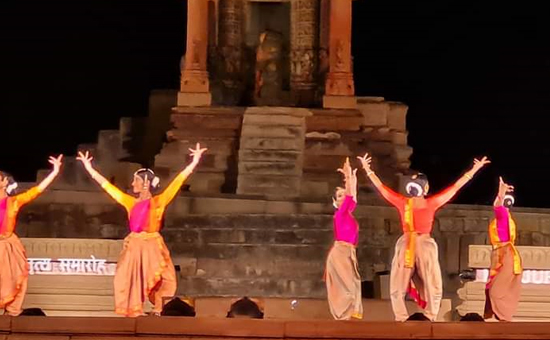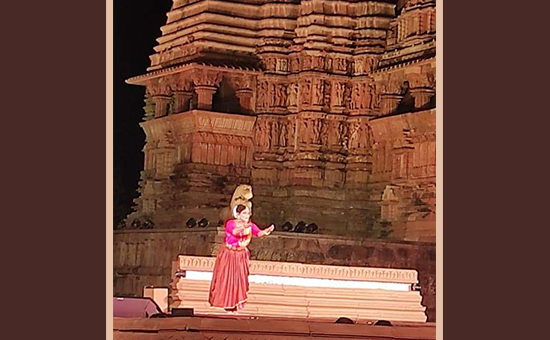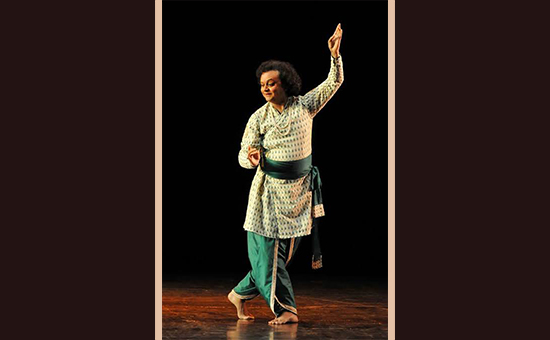- Article tells about the dance performances, with deeper
meaning, on day one of the Khajuraho Dance Festival 2021.
Khajuraho
Dance Festival 2021 takes you on an enchanting journey from real to surreal...
Built by the rulers of the Chandel Dynasty Khajuraho temples and sculptures symbolically represent Dharma, Artha, Kama and Moksha, which are the four goals of life in Indian philosophy, wherein the intricately carved sculptures take the observer through a journey from the external to the internal self.
Khajuraho Dance Festival is not only a festival, it's a divine amalgamation of Upasana, Sadhna and Aradhana i.e worship, meditation and devotion towards
the lord of Dance Natraj Mahadev, who's the protector and restorer of Khajuraho.
This year
the magnificent temples of Kandariya Mahadev again witnessed the dances after
47 years, as they used to be since the time of its inception, way back in 1975.
This was possible due to the support of the Archaeological Survey of India.
Today, the
Khajuraho festival has become an epitome of Sanskriti,
Paryatan and Adhyatma, bringing together Indian culture, tourism and spirituality on a single platform. Held this year from 20th-26th February at the Temple premises, this festival brings life to these exotic temples of yesteryears which were once the centres of dance and music in the Chandel era.
The festival began with an invocation by the Bharatnatyam exponent Padmashree Awardee Geeta Chandran who is known for her deep understanding of Indian classical dance nuances. Chandran infused yet again a rare theme in her first dance piece 'Alarippu' presenting 'Anekant' with her group Natya Vraksha.
 Geetaji performing at Khajuraho. Pic her Facebook page.
Geetaji performing at Khajuraho. Pic her Facebook page.
'Anekant' symbolises different visions (Drishtikone) or perspectives towards life or a thing, wherein every vision has its stand, bringing forward different paths towards exploring and experiencing life and its truths. Presented in four parts 'Anekant' was not only a visual treat, but an intellectual delight that represented a journey of thoughts from the physical to the metaphysical plane. Various
perspectives were depicted through many geometrical formations representing the
internal battle of the human mind, when the thoughts just turn and twist,
interrupt and then flow smoothly, are repeated or leads to a self- reflection.
The act portrayed the human psyche in a particular situation, creating
different visions and perspectives.
 Geetaji performing at Khajuraho. Pic her Facebook page.
Geetaji performing at Khajuraho. Pic her Facebook page.
Her next composition 'Maye' represented the combination of divine opposites Vyakta (told) and Avyakta (untold), Aakar
(with shape) and Nirakar (shapeless),
Sagun (worship of God with a form) and
Nirgun (Worship of God which is formless) based on a composition by Muthuswami
Dikshitar. The presentation was indeed a reflection of human life portraying us
all as puppets in the hands of one supreme power, wherein life appears like a Maya, an illusion. What appears as
reality fades away or disappears when we want to attain it, keeping us
wondering what is real and what is unreal. It keeps going on while we are stuck
in the rounds of karma, unless we come across a surreal experience of the
divine power which is the only reality that one must surrender to.
Her last
composition Grih-bhed depicted Anekant via notes. It was how the
different notes and combinations portray various situations in life and how
their varied expressions are depicted in Dance through corresponding
formations. Each formation was formed on the composition beginning with a
different note creating a different Saptak
(octave) with the same note (sa -Sa), (re-Re), (ma-Ma).
The first day of the program was concluded by a scintillating performance by Pandit Deepak Maharajji, the son and disciple of legendary Kathak exponent Pt. Birju Maharajji, who belongs to the illustrious Kalka Bindadin Gharana of Kathak.
 Pandit Deepak ji performance. Pic courtesy his Facebook page.
Pandit Deepak ji performance. Pic courtesy his Facebook page.
Maharajji
began his presentation with a Shiv Stuti Mahadev
Shiv Shambhu Har Har Adidev a traditional composition composed by his great
grandfather Pandit Kalka Bindadin Maharaj. With his projecting gestures and
facial expressions (Bhav-Mudra) along
with elegant hands and eye movements, he portrayed the very persona of Shiva
depicting his coiled hair (jata)
adorned with a crescent moon, while he brought the Ganges to earth trickling
through his hair. His third eye bestows an inward vision, but is capable of
bringing destruction when focused outwardly. He adorns the Deerskin, a garland
of skulls and a serpent around his neck and dances in frenzy with a Dumru and Trishul in his hands, as the Nandi and the Gods praise him.
Further, threading the pure dance in teen taal with a 'Bhav', he demonstrated how 16 Gopis reach out to Krishna. Through Uppaj
he showed the various ways to meet the sam
which symbolically represents how Gopis find different ways to reach Krishna
their beloved. Maharajji gave short glimpses of Thaat, Uthaan, Aamad, Paran, Chakradar Tirtha
as part of the traditional repertoire of Lucknow.
He performed the characteristic 'Thaat' with elegant slow circular torso movements followed by expressing the Bhav
hidden within the Uthaan. A perfect combination of 'Abhinaya', 'Bhav' and 'Chhand' brought his performance to life with impressive footwork and characteristic grace and elegance that Lucknow Gharana bestows.
One could
actually feel a dialogue between the Ghungroos and the Rhythm with an excellent accompaniment by the young tabla performer Pranshu Chaturlal on tabla, while the Tihai's and Mukhras of various bandishes came swiftly on the 'sam' showcasing the artistry of both the performers during a jugalbandi.
Maharajji
displayed many Parans with the
enunciation of Patakshars (Tabla
bols) with extreme clarity. He concluded his recital with a Gat-Bhav showcasing the 'Abhinaya Ang' where he enacted three roles of a Kathakar, Krishna and Jashoda Maiya simultaneously depicting Makhan Chori. Krishna with his bunch of Sakha's steal opens to eat Makhan from a matki, while Yashoda Maiya goes to fetch water and later when she returns, finds what has happened in her absence. On one hand, she shows her anger and on the other adores Krishna and his naughtiness depicting the Vatsalya Srinagar bhav. While the naughty Krishna is too aware of
the tight scolding he would receive, but at the same time knows how to calm her
down with his utter cuteness!
To see Live Festival Performances on Facebook
Author attended the Khajuraho Dance Festival 2021. All pics provided by author.
To read all
articles by author
Also see and read
1. Pics
of Khajuraho Dance Festival 2014
2. Pics
of Kandariya Mahadev Mandir
3. Pics
of Lakshmana Mandir
4. Pics
of Khajuraho Temples Western
5. Pics
of Orchha
6. Deeper
meaning behind erotic sculptures of Khajuraho
7. Konarak
Dance Festival
8. Kuchipudi
Dance at Elephanta Festival
9. Folk
dances of Assam